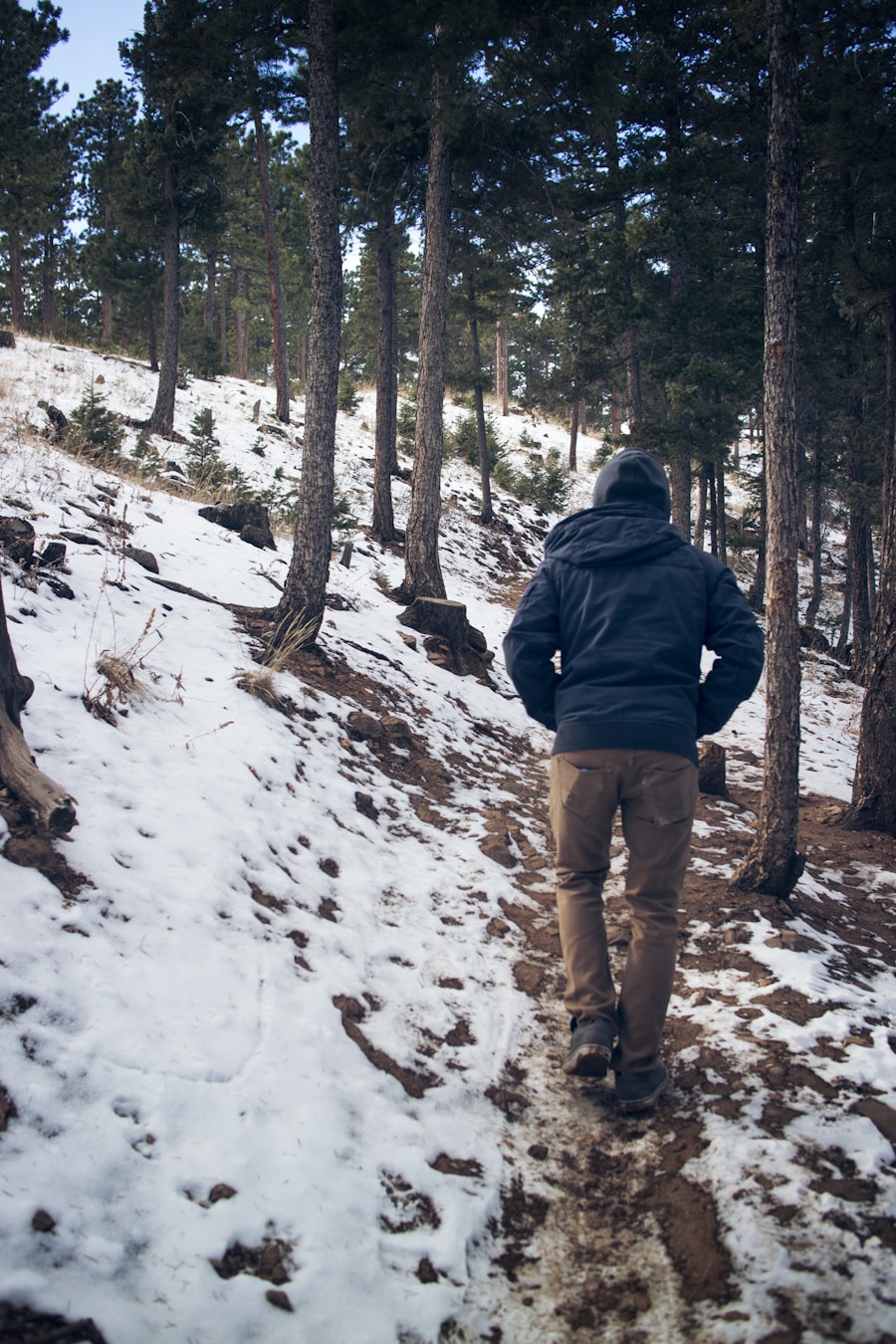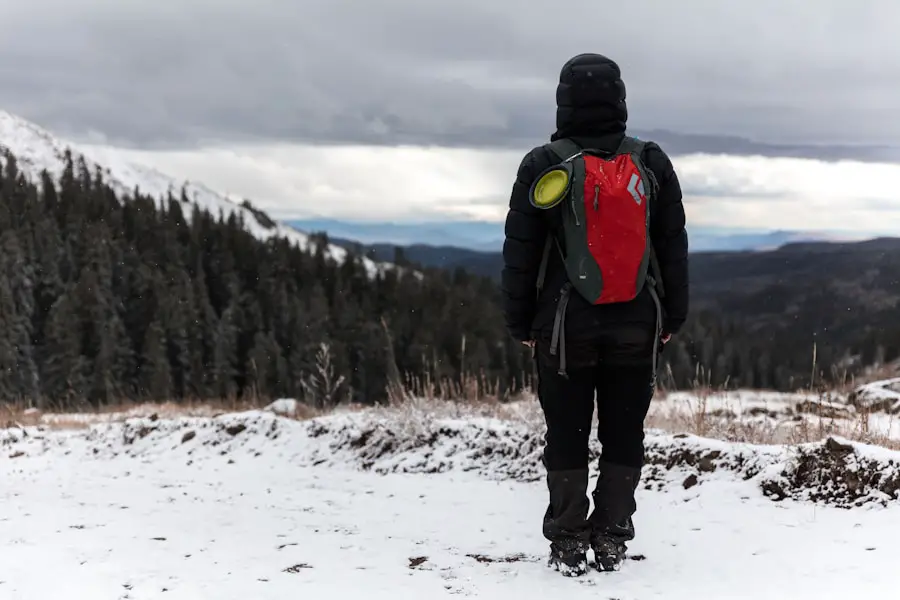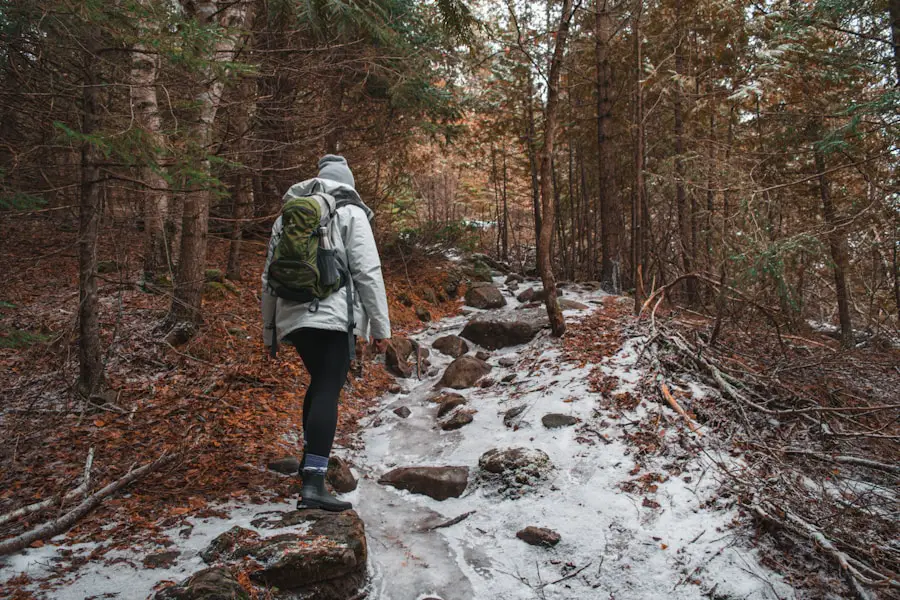Layering clothing is a fundamental strategy for staying warm and comfortable in cold weather conditions. The principle behind layering is to create a system of clothing that can be adjusted according to the temperature and activity level. The base layer, which is worn closest to the skin, is typically made from moisture-wicking materials such as merino wool or synthetic fabrics.
These materials help to draw sweat away from the body, keeping the skin dry and reducing the risk of hypothermia. A good base layer should fit snugly without being restrictive, allowing for freedom of movement while effectively managing moisture. The middle layer serves as insulation, trapping heat close to the body.
Fleece jackets, down vests, or synthetic insulated jackets are popular choices for this layer. The key is to select materials that provide warmth without adding excessive bulk. For instance, a lightweight fleece can offer significant warmth while allowing for easy layering under a waterproof shell.
The outer layer, or shell, is designed to protect against wind, rain, and snow. This layer should be breathable yet waterproof, allowing moisture from sweat to escape while preventing external moisture from penetrating. A well-constructed shell jacket can make a significant difference in overall comfort during outdoor activities in cold weather.
Key Takeaways
- Layering clothing is essential for staying warm in cold weather, as it allows for easy adjustment as temperatures change.
- Insulated boots are a must-have for keeping feet warm and dry in snowy or wet conditions.
- Waterproof outerwear is crucial for staying dry and comfortable in rainy or snowy weather.
- Gloves and hats are important for protecting the extremities from cold temperatures and wind chill.
- Hand and foot warmers can provide extra warmth in extremely cold conditions, making them a valuable addition to any winter gear kit.
Insulated Boots
Insulated boots are essential for maintaining warmth and comfort in frigid conditions. When selecting insulated footwear, it is crucial to consider both insulation type and boot construction. Many insulated boots utilize materials such as Thinsulate or down for their excellent thermal properties.
Thinsulate, for example, is a synthetic insulation that provides warmth without adding excessive weight or bulk, making it ideal for active pursuits like hiking or snowshoeing. Additionally, the construction of the boot plays a vital role in its effectiveness; features such as a waterproof membrane and sealed seams can prevent moisture from seeping in while keeping feet warm and dry. Another important aspect of insulated boots is their fit.
A well-fitting boot should allow for some wiggle room in the toes while providing adequate support around the ankle. This balance is crucial because overly tight boots can restrict circulation, leading to cold feet, while excessively loose boots can cause blisters and discomfort during extended wear. Furthermore, many insulated boots come with removable liners that can be dried out after a day of use, enhancing comfort and prolonging the life of the footwear.
When venturing into cold environments, investing in high-quality insulated boots can significantly enhance your overall experience.
Waterproof Outerwear

Waterproof outerwear is a critical component of any cold-weather outfit, especially in regions where snow and rain are prevalent. The effectiveness of waterproof clothing is determined by its material and construction. High-quality waterproof jackets often feature advanced technologies such as Gore-Tex or similar membranes that provide both waterproofing and breathability.
These materials allow sweat vapor to escape while preventing water from entering, which is essential for maintaining comfort during physical activities in wet conditions. In addition to the fabric technology, the design of waterproof outerwear also plays a significant role in its performance. Features such as adjustable hoods, cuffs, and hemlines can help seal out wind and moisture, while ventilation zippers allow for temperature regulation during strenuous activities.
Pockets should be strategically placed and secured with waterproof zippers to protect essential items from getting wet. When selecting waterproof outerwear, it’s important to consider not only the level of waterproofing but also how well it fits over your base and insulating layers. A well-fitted waterproof jacket can provide an effective barrier against the elements while allowing for ease of movement.
Gloves and Hats
| Month | Gloves Sold | Hats Sold |
|---|---|---|
| January | 550 | 400 |
| February | 600 | 450 |
| March | 700 | 500 |
| April | 750 | 550 |
Gloves and hats are often overlooked but are vital accessories for maintaining warmth in cold weather. The head is one of the primary areas where heat escapes from the body; therefore, wearing a hat can significantly reduce heat loss. Materials such as wool or fleece are excellent choices for hats because they provide warmth while remaining breathable.
Additionally, hats with ear flaps or those that cover the neck can offer extra protection against biting winds. Gloves are equally important, as hands are particularly susceptible to cold due to their exposure and lower blood circulation compared to other body parts. Insulated gloves made from materials like Thinsulate or down can keep hands warm even in frigid temperatures.
It’s also beneficial to choose gloves with a waterproof outer layer if you anticipate exposure to snow or rain. Mittens can be an excellent alternative to gloves for extreme cold since they allow fingers to share warmth; however, they may limit dexterity for tasks requiring fine motor skills. Ultimately, selecting the right gloves and hats tailored to your specific activities will enhance your comfort and enjoyment during outdoor adventures.
Hand and Foot Warmers
Hand and foot warmers are practical accessories that can provide additional warmth during cold weather activities. These small packets typically contain iron powder, salt, activated charcoal, and vermiculite; when exposed to air, they undergo an exothermic reaction that generates heat. Hand warmers can be slipped into pockets or gloves, providing immediate relief from the cold when needed most.
They are particularly useful during long periods of inactivity, such as waiting at a bus stop or sitting on a ski lift. Foot warmers function similarly but are designed specifically for placement inside shoes or boots. Some brands offer adhesive foot warmers that stick directly to the insole of your footwear, ensuring they stay in place throughout your activities.
For those who engage in winter sports or spend extended periods outdoors, these warmers can be a game-changer in maintaining comfort and preventing frostbite. Additionally, rechargeable battery-operated warmers are available on the market today; these devices can provide consistent heat over several hours and can be reused multiple times, making them an eco-friendly option for avid outdoor enthusiasts.
Navigation Tools

When venturing into remote areas during winter months, having reliable navigation tools is essential for safety and efficiency. Traditional maps and compasses remain valuable resources; however, modern technology has introduced GPS devices and smartphone applications that offer enhanced functionality. GPS devices designed for outdoor use often come equipped with features such as topographic maps, waypoint marking, and route planning capabilities that can significantly aid navigation in challenging conditions.
Smartphone applications have also revolutionized navigation by providing real-time tracking and location sharing features. Many apps allow users to download maps for offline use, which is particularly useful in areas with limited cell service. However, it’s important to ensure that devices are adequately protected against cold weather; batteries tend to drain faster in low temperatures, so carrying extra power banks or using insulated cases can help maintain functionality throughout your journey.
Regardless of the tools chosen, understanding how to read maps and use a compass remains an invaluable skill that complements modern technology.
Emergency Supplies
Emergency supplies are an often-overlooked aspect of winter preparedness but are crucial for ensuring safety during outdoor excursions. A well-stocked emergency kit should include items such as a first aid kit, flashlight with extra batteries, multi-tool or knife, fire-starting materials (like waterproof matches or lighters), and emergency blankets designed to retain body heat. These supplies can be lifesaving in situations where one becomes stranded or injured.
In addition to basic supplies, it’s wise to include food items that require no cooking or preparation—such as energy bars or dried fruit—along with plenty of water or water purification tablets. In winter conditions, staying hydrated is just as important as staying warm; dehydration can occur even in cold weather due to increased respiratory loss of moisture. Furthermore, signaling devices like whistles or reflective mirrors can be invaluable for attracting attention if you find yourself lost or in distress.
Preparing an emergency kit tailored to your specific activities will enhance your safety and peace of mind when exploring winter landscapes.
Backpack with Supportive Straps
A well-designed backpack with supportive straps is essential for carrying gear comfortably during winter adventures. When selecting a backpack, look for features such as padded shoulder straps that distribute weight evenly across the shoulders and back. A hip belt can also help transfer some of the load from the shoulders to the hips, reducing fatigue during long hikes or climbs.
Additionally, consider backpacks with multiple compartments and external attachment points for gear like trekking poles or snowshoes. This organization allows for easy access to essentials without having to dig through the entire pack. Hydration reservoirs or pockets designed for water bottles are also beneficial features that encourage regular hydration on the go.
Ultimately, investing in a high-quality backpack tailored to your specific needs will enhance your overall experience by providing comfort and convenience during winter excursions.
When preparing for a cold weather hiking trip, it’s important to not only dress appropriately but also pack efficiently. One essential item to consider bringing along is a lightweight laptop for travel, such as the ones recommended in this article. Having a reliable laptop can come in handy for staying connected, editing photos, or simply passing the time during downtime on the trail. Additionally, investing in a durable hardside carry-on luggage with spinner wheels, like the ones featured in this article, can make transporting your gear to and from the trailhead a breeze. And don’t forget to protect your camera gear by using a high-quality travel camera backpack, as suggested in this
